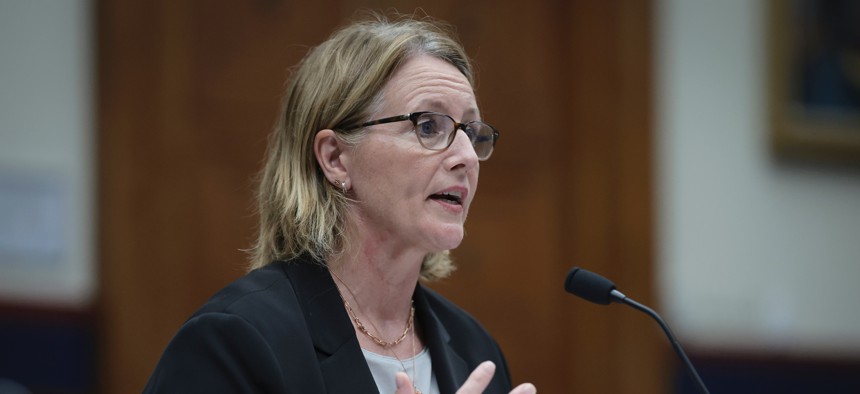
FEMA Administrator Deanne Criswell recently told Congress that legislative efforts have helped improve recruiting at the agency, but a new bill would require more definitive talent management plans. Win McNamee / Getty Images
Under-resourced FEMA would see new commitment to growing workforce under bipartisan bill
The agency has struggled to keep pace with new and increased demands.
A bipartisan pair of senators is looking to force the Federal Emergency Management Agency to better plan for its staffing needs following longstanding concerns the disaster response component lacks the requisite capacity for modern demands.
The FEMA Workforce Planning Act (S. 4181) would give the agency one year to develop a specific blueprint for its human capital requirements, which it would then have to update every three years. The plan would include performance measures for meeting workforce goals, an explanation of barriers to reaching its staffing needs and the types of employees and hiring authorities it will use to boost its rolls. It would also detail projected attrition and skill gaps, with specific numbers attached, and details of how to address those shortfalls.
FEMA “must ensure it has the workforce in place to meet the needs of any disaster,” said Sen. Gary Peters, D-Mich., who chairs the Senate Homeland Security and Governmental Affairs Committee and introduced the bill with Sen. Bill Cassidy, R-La. “My bipartisan bill will ensure FEMA is properly staffed to provide reliable assistance to survivors of natural disasters.”
FEMA employees in recent years have deployed to natural disaster sites, wildfires, the U.S.-Mexico border, in support of the resettling of Afghan evacuees and for pandemic assistance, all while dealing with a staff 6,000 workers short of the agency’s goal. Employees have warned they are fatigued due to the lack of downtime between deployments and said burnout is spiking as they no longer experience a true offseason.
A recent Government Accountability Office report found staffing shortages have forced FEMA to function at 65% of its operating capacity. The biggest impact, it said, was on the long-term recovery impacts, with FEMA’s ongoing projects dating back to Hurricane Katrina response. In 2017, the watchdog added, FEMA deployed 3,300 staff and reservists per day, whereas today that number has more than doubled to 7,000.
Peters and Cassidy’s bill would require FEMA to create strategies for recruiting, training, developing, motivating and retaining employees. It would also task the agency with disclosing more details on its Surge Capacity Force—its cadre of federal employees at other components and agencies who volunteer to deploy to disaster sites when needed—and its plan for further developing it. As part of its workforce plan, FEMA would also have to share information on all cases related to harassment and discrimination in the workforce.
FEMA reservists have told Government Executive that new hires were receiving insufficient training before deployment and some employees were working 12-hour days for a month straight. The agency has frequently tapped volunteers throughout the Homeland Security Department and elsewhere in government to help supplement its efforts. GAO has also found that at times of peak deployments, such as when several major hurricanes hit in 2017, 54% of staff were serving in capacities in which they were not formally certified.
Employees and GAO have said burnout at FEMA has increased since the pandemic and recruiting remains a challenge since most of its staff are reservists who only work part of the year. The benefit for those employees was frequently that they had months of break in between deployment, but increasingly the workers—particularly those with specialized skills—are being sent from one disaster to the next without any time off.
FEMA Administrator Deanne Criswell recently told Congress she was optimistic her agency is better retaining its part-time workforce after Congress passed the Civilian Reservist Emergency Workforce Act to provide those employees who leave their day jobs to address disasters with the same protections as members of the armed forces deployed to active duty. She also said recruitment bonuses are helping to bring in more employees, as FEMA has been regularly onboarding new personnel every two weeks.
Under the new bill, the watchdog would review FEMA’s workforce plan to assess its effectiveness and recommend change. FEMA would also be responsible for identifying legislative assistance it would require from Congress to boost its capacity. Criswell told lawmakers earlier this year she would see benefits to a different system in which FEMA reservists serve more like the National Guard, wherein they regularly engage in training while not actively deployed.







